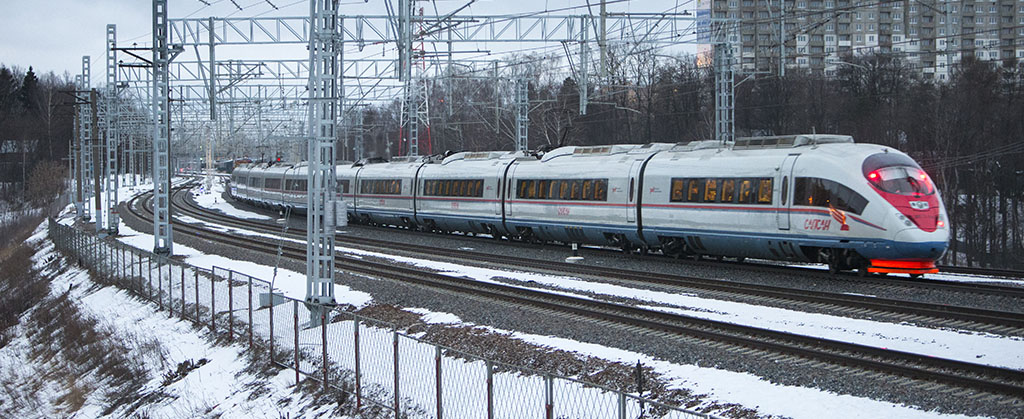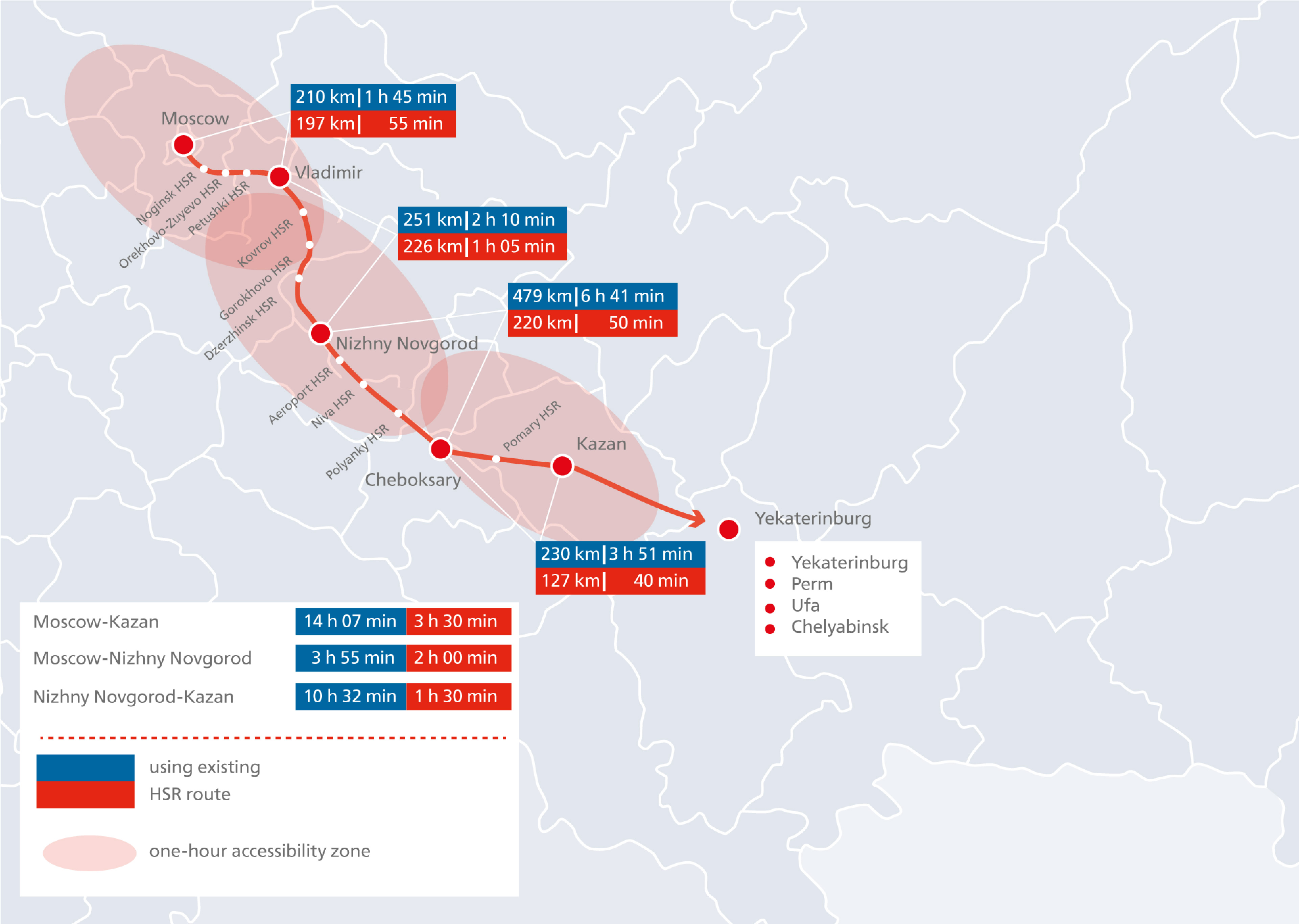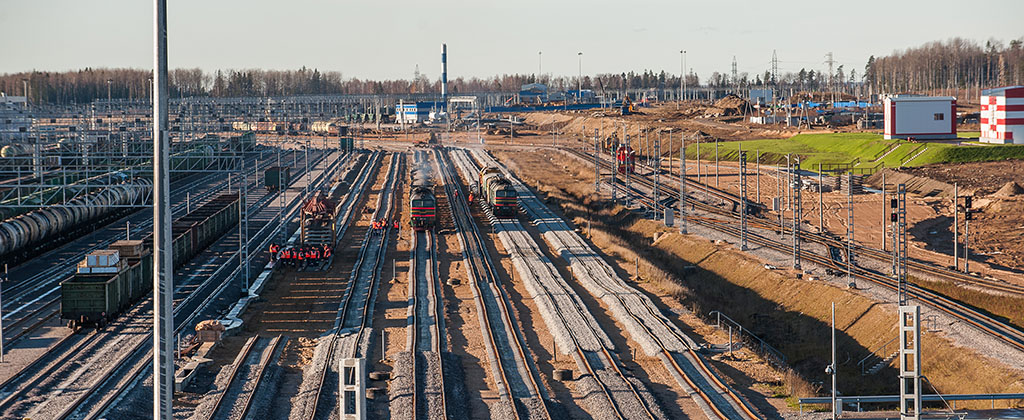High-speed transportation
High-speed passenger transportation is handled by the High-Speed Transportation Directorate (HSTD), a branch of Russian Railways, and Federal Passenger Company.
Passenger turnover via high-speed trains grew by 24.3% to 4.6 bln pass. km in 2016. Passenger turnover increased both domestically and internationally.
The number of passengers transported by high-speed trains increased by 19.1% to 9.2 mln in 2016 compared with 2015. In particular, Sapsan and Lastochka (Desiro RUS) trains carried 5.9 mln passengers on long-haul domestic routes (growth of 27.4%), while Allegro trains carried 0.2 mln passengers on international routes (increase of 8.8%).
An increase in passenger traffic between Russia and Finland occurred due to the ‘Plan in Advance’ promotional campaign and also due to the stabilisation of the Russian national currency.
Double-decker Sapsan trains continued to operate in 2016 following their launch in August 2014 via the Moscow – St Petersburg route. The Sapsan train occupancy rate was 81.3% for the year (80.3% in 2015). Active efforts to concentrate Sapsan high-speed trains on the Moscow – St Petersburg route helped railway transportation to maintain a 69.7% share of this route (+3.7 p.p. versus 2015).
High-speed Strizh trains started running on the Moscow – Berlin route on 17 December 2016.
Since high-speed trains were put into operation until 1 January 2017, total passenger transportation amounts to:
- Sapsan – 22.7 mln passengers;
- Allegro – 2.3 mln passengers;
- Lastochka (Desiro RUS) – 9.2 mln passengers;
- Strizh – 1.9 mln passenger.
As of 1 October 2016, the High-Speed Transportation Directorate had 16 high-speed Sapsan trains, 94 high-speed Lastochka (Desiro RUS) trains, including 54 ES1 trains produced by Siemens and 44 ES2G trains manufactured by Ural Locomotives, and two Pesa railcars. In addition, the Directorate operates Allegro trains leased by Russian Railways from the Finnish-Russian company Oy Karelian Trains. As part of a project, the High-Speed Transportation Directorate also performs work involving the maintenance of Allegro trains jointly with Finnish Railways (VR Group Ltd).

Implementation of rapid-transit and high-speed transportation projects
Moscow – Kazan High-Speed Railway

| Railway location | Moscow, Moscow Region, Vladimir Region, Nizhny Novgorod Region, Chuvash Republic, Mari-El Republic and the Republic of Tatarstan |
|---|---|
| Length | 770 км |
| Travel time from Moscow to Kazan | 3 h 30 min |
| Maximum speed | Up to 400 km/h |
| Gauge width | 1,520 mm |
Russian Railways systematically prepared for the construction of the first Russian-made high-speed railway – the Moscow – Kazan HSR, which was approved by Order No. 5-r of the Government of the Russian Federation dated 13 January 2016.
The main efforts were focused on meeting the following objectives:
- performance of survey and design work to draft design documentation for the construction of the railway;
- creation of a regulatory and technical framework for the design, construction and operation of HSR infrastructure and high-speed rolling stock;
- creation of a regulatory and legislative framework to establish high-speed transportation in the Russian Federation;
- creation of the necessary mechanisms to implement infrastructure projects based on a public-private partnership and concessions;
- establishment and organisation of the manufacturing of a line of high-speed rolling stock in Russia;
- updating of the organisational and legal model for implementing the project and work with potential national and international investors to agree on the conditions for their involvement in the project, attract investment and the forms of cooperation.
The railway was designed in accordance with Design Contract No. 25/15 dated 18 June 2015. To date, 67% of the total work under the contract has been performed, and RUB 12.6 bln of the total RUB 18.9 bln has been spent.
Jointly with High-Speed Railways, a Russian-Chinese consortium of design organisations and French technical consultants (Systra, SNCF), Russian Railways has fully completed a set of engineering surveys and drafted design documentation for the construction for the first section of the Moscow – Nizhny Novgorod railway.
Documentation has been drafted and approved by the Russian Ministry of Construction to configure the territory for the construction of railways in the Moscow, Vladimir and Nizhny Novgorod Regions, and documentation for the construction of railways in Moscow, Mari El Republic, Chuvash Republic and the Republic of Tatarstan has been submitted to the ministry for endorsement and approval.
The construction of the HSR will utilise the best and leading technical solutions for high-speed train traffic of up to 400 km/h based on the practice of building and operating high-speed railway lines. This includes a ballast-less track superstructure for speeds of up to 400 km/h (more than 1,400 km projected). The design, which was specifically developed for Russia, takes into account European and Chinese experience, including operation on the Harbin – Dalian section with climatic conditions similar to those in Russia.
The KS-400 contact network has been specially designed for the railway based on mathematical modelling (more than 1,700 km projected). The modelling results have been confirmed by the scientific community of leading countries.
More than 150 km of the Moscow – Kazan HSR will pass through engineering structures – bridges and overpasses that do not intersect at any level with other transport lines. Uniform designs have been developed for the engineering structures with a range of speed from 200 to 350 km/h in order to ensure the technological uniformity of the design solutions. Span structures designed for the first time for such speeds served as the basis for unification.
Design work is scheduled to be completed in the first half of 2017.
In 2016, a concept was drafted to develop the territories surrounding the HSR, and data sheets were compiled for investment projects identifying the main areas and parameters for developing the territories.
A public technological and price audit of engineering surveys and design documentation for the Moscow – Nizhny Novgorod section was carried out, including an assessment of the technical requirements, limitations of high-speed rolling stock and its operation and maintenance technologies taking into account the proposed design solutions, which resulted in a favourable conclusion.
According to international auditors (Ernst & Young Consulting Services, TCIB Transport Consultants International Berlin GmbH & Co.KG and MOLINARI), the main technical and technological solutions provided in the project documentation meet the current level for the construction and operation of high-speed highways around the world.
The siting of the railway has been substantiated and selected to minimise capital expenditures on construction while meeting requirements for the safety and comfort of passenger transportation, and an analysis of passenger traffic confirms the parameters adopted in the design documentation.
The scope of the technical requirements for high-speed rolling stock fully corresponds to international practice, standards and competitive documentation in other countries.
The unit cost of building 1 km of the railway is consistent with the average price range relative to international analogues, while the specific operating costs correspond to global practice.
Over the course of 2016, measures were taken that are required to adopt regulations on amendments to the legislation of the Russian Federation, including as part of preparations for the expropriation of land plots and real estate properties.
A programme for the scientific and technical support of the construction of high-speed railways and rolling stock was approved by the Federal Railway Transportation Agency following updates by Russian Railways.
Taking into account the design results, special technical specifications for the design and operation of the Moscow – Kazan HSR were updated, and national standards were developed for high-speed railway lines.
The organisational, legal and financial models for implementing the project as well as the investment declaration were updated, and the main provisions of concession and direct agreements as well as shareholder and loan agreements as part of the concession were drafted.

The Company continued work on cooperation with potential investors, including investors from China, Germany and Italy, as part of the implementation of Moscow – Kazan HSR. Proposals were received from potential investors on the conditions for providing debt and equity financing. Work is under way to agree on forms of cooperation and financing parameters that are acceptable to Russia.
Technical requirements for high-speed rolling stock have been drafted and approved as part of the project. The projected train will have an operating speed of up to 360 km/h, and up to 400 km/h in the testing process, with seating capacity for 680 passengers.
A concept has been developed for a high-speed special-purpose freight train with structural features designed to transport between 300 and 600 tonnes of container cargo at speeds of up to 300 km/h.
Agreements of intent concerning the localisation of high-speed railway rolling stock and railway equipment in the Russian Federation were signed during meetings of the presidents of Russia and China in Beijing on 25 June 2016.
The construction of the Moscow – Kazan HSR with an extension to Yekaterinburg and eventually to Beijing as well as the development of the network running towards the European Union will make it possible to unite the Euro Carex network that is currently being built in Europe with speeds of up to 250 km/h and create a “high-speed freight and passenger bridge” between the transport networks of China and Europe.
This ambitious project will not only become one of the key links in the Eurasian transport communications system, but will ensure a direct interface for the Eurasian Economic Union and China’s Silk Road Economic Belt project.
According to preliminary estimates, taking into account the East-West trade turnover volume, the proportion of routes passing through Russia could exceed 15% with additional revenue for Russian Railways of more than RUB 300 bln per year (in 2016 prices). Following the approval of the organisational, legal and financial models for the implementation of the investment project to build the Moscow – Kazan HSR at a meeting of an interdepartmental working group on matters concerning the implementation of the project, a proposal will be submitted to the Government of the Russian Federation on the conclusion of a concession agreement with construction subsequently being launched in the second half of 2017.
